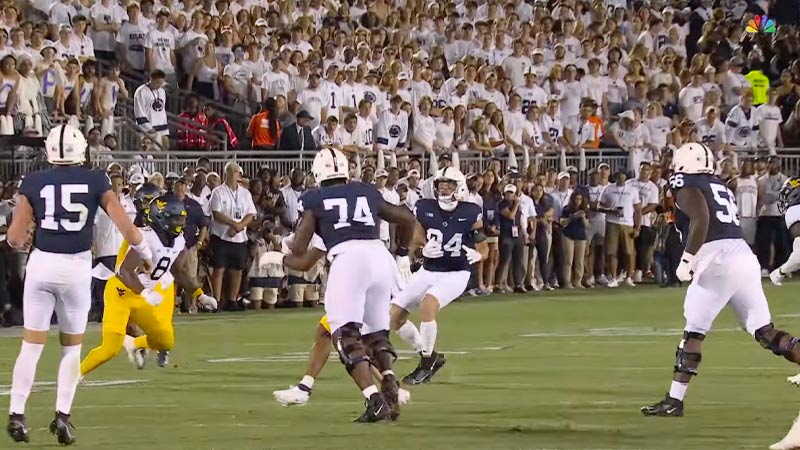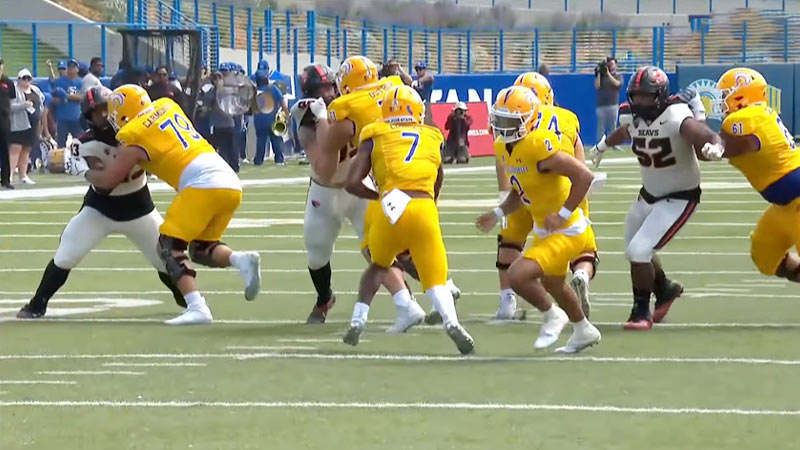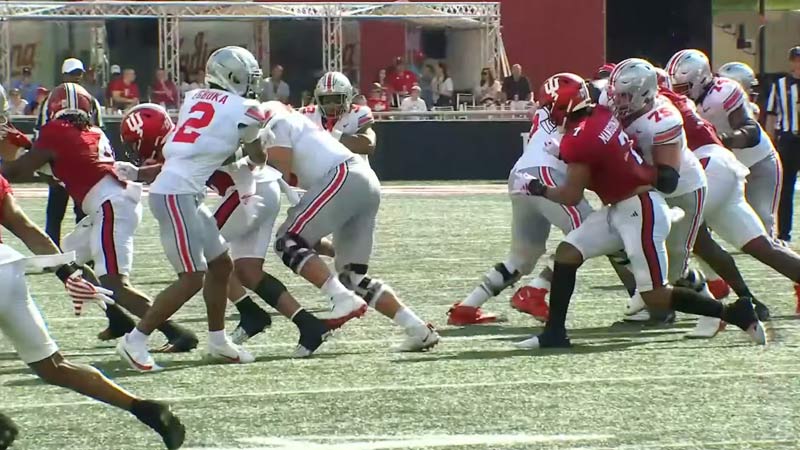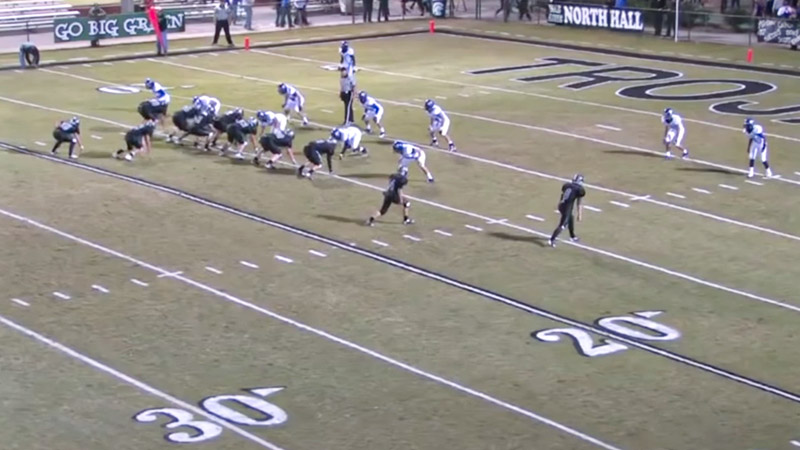In the intricate world of American football, offensive strategies have evolved significantly over the years, each leaving its mark on the game’s history. One such formation that gained prominence in the 20th century is the football wishbone offense.
Rooted in deception, misdirection, and a relentless ground attack, the wishbone offense left an indelible mark on the sport, transforming the way teams approached their offensive game plans.
In this blog post, we will try to unravel the secrets behind the Wishbone offense, exploring its strategies, historical significance, and its place in the modern football landscape.
What Is a Football Wishbone Offense?
The football wishbone offense is a strategic offensive formation characterized by its distinctive “wishbone” shape. In this setup, the quarterback lines up under center, flanked by a fullback close behind and two halfbacks positioned slightly further back, forming an inverted Y configuration.
This offensive approach gained immense popularity in the 1970s and 1980s, particularly in college football.
By employing this formation, teams aimed to create a versatile rushing attack that could confuse defenses with its multiple options for ball carriers. The wishbone offense allowed for quick pitch options, misdirection plays, and the potential for a balanced run-pass threat.
Its success rested on the synchronization of the backfield players’ movements, making it a memorable and impactful strategy in football history.
Elements of Wishbone Offence

The key elements of a Wishbone offense include:
Formation
The wishbone formation involves the quarterback taking the snap from under center, with a fullback positioned closely behind them.
Two halfbacks (also known as tailbacks) are positioned further back, with one slightly to the left and the other slightly to the right. The alignment of these four backs creates a distinctive wishbone shape.
Triple Option
The primary offensive strategy in the Wishbone offense is often centered around the triple-option play.
This play allows the quarterback to read the defensive players and decide whether to hand the ball off to the fullback, keep it themselves, or pitch it to one of the halfbacks. This read-and-react approach can confuse the defense and create opportunities for big gains.
Ball Distribution
The triple option play and other variations within the Wishbone offense require precise timing and decision-making. The quarterback’s ability to make quick decisions based on the defense’s movements is crucial in executing this strategy effectively.
Ground Game Emphasis
The Wishbone offense heavily emphasizes the running game, with a focus on gaining yards on the ground rather than relying heavily on passing.
The formation and play designs are optimized to create rushing lanes and exploit defensive weaknesses in order to move the ball down the field.
Misdirection and Play Action
The wishbone formation often incorporates misdirection plays and play-action passes to keep the defense off-balance. The close positioning of the backs and the potential for multiple ball carriers can confuse defenders and open up opportunities for big plays.
Time of Possession
Because the Wishbone offense relies heavily on running the ball and controlling the clock, it can help a team maintain time of possession and keep the opposing offense off the field.
Physicality
The Wishbone offense requires a strong offensive line and physically capable running backs. The fullback, in particular, plays a pivotal role in both blocking and carrying the ball.
While the Wishbone offense was popular in its heyday, football strategies, and formations have evolved over time.
Defenses have adapted to counter the triple option and other aspects of the Wishbone offense. As a result, while elements of the Wishbone may still be incorporated into modern offensive schemes, it’s not as prevalent as it once was.
History of Football Wishbone Offense

The history of the football wishbone offense is a tale that spans several decades, originating from the innovative minds of coaches seeking to revolutionize offensive strategies.
Early Innovations and Influences (1950s)
Although the wishbone formation is commonly associated with Emory Bellard’s work at Texas in 1968, its conceptual origins can be traced back to earlier years.
In the 1950s, coaches began experimenting with variations of the split-back formation, seeking ways to enhance their rushing attacks and create tactical advantages.
Darryl Royal and the Birth of the Modern Wishbone (1968)
The Wishbone offense found its most renowned innovator in Emory Bellard, who, as offensive coordinator at the University of Texas, took the concept of a balanced rushing attack to new heights.
Collaborating with head coach Darryl Royal and assistant Mike Campbell, Bellard refined and implemented what would become the wishbone offense.
The crucial shift was the alignment of the fullback and two halfbacks, creating the iconic inverted Y shape. In 1968, Texas introduced this revolutionary formation, capturing national attention.
Strategic Advantages and Dominance (1970s-1980s)
Wishbone’s popularity surged throughout the 1970s and 1980s, especially in college football. Teams like Texas, Oklahoma, and Alabama embraced the offense, exploiting its multi-dimensional nature.
The wishbone’s core strengths lay in its ability to create confusion through misdirection, quick pitch options, and the threat of both inside and outside runs.
Defenses struggled to anticipate which back would carry the ball, and this uncertainty provided offensive teams a substantial advantage.
Adaptations and Challenges
As the wishbone gained prominence, opposing defenses began devising strategies to counter its effectiveness. The 1980s saw the rise of more diverse defensive schemes, such as the 3-4 and 4-3 alignments, aimed at containing the Wishbone’s ground game.
Coaches responded by tweaking formations, incorporating passing elements, and developing hybrid offenses that blended wishbone principles with modern passing attacks.
Legacy and Influence
The Wishbone offense left an indelible mark on football history. Its impact extended beyond the field, influencing coaching philosophies and offensive innovations for years to come.
Concepts from the wishbone were integrated into spread offenses and read-option strategies, maintaining its legacy in a new era of football.
The history of the football wishbone offense reflects the evolution of tactical thinking in the sport. From its experimental beginnings in the 1950s to its explosive popularity in the 1970s and 1980s, the wishbone formation showcased the power of innovation in shaping the game.
When to Use Football Wishbone Offense?

The football wishbone offense is a strategic formation that can be used in specific situations to exploit its unique advantages. While the wishbone has seen less frequent use in modern football due to defensive adaptations and evolving offensive strategies, there are still scenarios where it can be effective:
Ground Dominance
The Wishbone offense is particularly effective at establishing a dominant rushing attack. If a team has a group of talented running backs and a strong offensive line, the wishbone can create misdirection and quick pitch options that keep the defense off-balance.
It’s useful for controlling the clock, wearing down the opposing defense, and grinding out tough yards on the ground.
Ball Control
When a team aims to control possession and limit the opponent’s opportunities, the wishbone can be a valuable asset. The combination of quick-hitting runs and misdirection plays can eat up the clock and limit the opposing offense’s time of possession.
Overwhelming Defensive Fronts
If an opposing defense is struggling to defend against the run or is heavily oriented toward pass defense, the wishbone can exploit this weakness.
By consistently attacking with multiple rushing threats, the Wishbone can exploit gaps in the defense and capitalize on overcommitted defensive linemen or linebackers.
Short Yardage and Goal Line Situations
The wishbone formation’s power and quick-hitting options make it well-suited for short-yardage and goal-line situations. With the ability to quickly dive into the line or utilize pitch options, the offense can attack the defense’s vulnerabilities in close-quarters situations.
Exploiting Defensive Aggression
Defenses that are overly aggressive can be vulnerable to the wishbone’s misdirection and pitch plays. By using the defense’s momentum against them, the wishbone offense can create big plays by catching defenders out of position.
Change of Pace
In a game where an offense primarily uses a different formation or strategy, switching to the wishbone on occasion can catch the defense off-guard. The sudden shift in offensive approach can disrupt the defense’s rhythm and lead to unexpected gains.
It’s important to note that while the wishbone has its advantages, it also has limitations. Modern defenses are well-equipped to handle traditional rushing attacks, and passing threats are crucial for a well-rounded offense.
As such, the wishbone is often used in conjunction with passing plays or as a situational change of pace. Its success relies on a combination of skilled running backs, effective play-calling, and the element of surprise.
Strategies of Football Wishbone Offense

The football Wishbone offense employs various strategies to maximize its effectiveness on the field. These strategies revolve around misdirection, ball distribution, and exploiting defensive weaknesses.
Here are some key strategies associated with the Wishbone offense:
Misdirection
Central to wishbone’s success is misdirection. The offense aims to confuse the defense by presenting multiple potential ball carriers and directions for the play. Quick pitch options, counters, and fakes are used to keep the defense off balance and create opportunities for big gains.
Triple Option
The triple option is a hallmark of the Wishbone offense. The quarterback reads the defense after the snap, deciding whether to hand the ball off to the fullback up the middle, keep it and run along the line of scrimmage, or pitch it to a trailing halfback.
This option-based strategy forces defenders to make split-second decisions, exploiting their hesitation.
Power Running Game
The Wishbone relies heavily on a power running game. With three potential ball carriers in close proximity, the offense can attack the line of scrimmage with force. The fullback dive, in particular, aims to gain quick and hard yards up the middle.
Quick Pitch and Sweep Plays
The wishbone often features quick pitch and sweep plays to the halfbacks. These plays take advantage of the offensive line’s blocking angles and aim to get the ball to the outside quickly, utilizing the speed and agility of the halfbacks to gain yards around the edges.
Play Action Pass
While the wishbone is predominantly a rushing formation, mixing in play-action passes can catch the defense off-guard.
By drawing defenders in with run fakes, the offense can create opportunities for deep passes to wide receivers who have beaten their coverage.
Ball Security
Given the close proximity of ball carriers in the wishbone formation, ball security is paramount. Fumbles can be disastrous in this offense, as the quick-hitting nature of the plays requires precise execution and timing.
Adaptation and Hybridization
In modern football, wishbone-based offenses may incorporate elements from other formations to maintain unpredictability. Incorporating spread concepts, read-option plays, and short passing routes can enhance the wishbone’s versatility.
Utilization of Skill Sets
Coaches must assess the strengths of their running backs and quarterback when implementing the wishbone. Players with speed and agility are suited for pitch plays, while powerful runners can excel in fullback dives.
The quarterback’s decision-making ability is crucial for successful triple-option execution.
Field Position Awareness
The wishbone offense can be used strategically based on field position. It’s especially effective in situations where ball control and clock management are important, such as when trying to run out the clock with a lead.
Surprise Element
The wishbone is most effective when opponents are not expecting it. Coaches can use it as a change of pace to catch defenses off-guard and exploit their lack of preparation for defending against the unique challenges posed by the formation.
Incorporating these strategies requires a deep understanding of the offense’s intricacies and the ability to adapt to defensive reactions. While the wishbone offense is not as prevalent in modern football, its principles continue to influence offensive innovation and game planning.
Pros of Football Wishbone Offense

The football wishbone offense offers several advantages that can benefit a team when executed effectively. While it might not be as commonly used in modern football, understanding its pros can shed light on its potential strengths:
Misdirection and Deception
The wishbone’s misdirection plays and multiple options for ball carriers can confuse and disrupt the defense’s assignments. The uncertainty of who has the ball can lead to defenders being out of position, creating open lanes for runners.
Run-First Approach
The wishbone is tailored for a run-first approach, which can be advantageous when a team has talented running backs and a strong offensive line. It enables the offense to control the tempo, maintain possession, and wear down the opposing defense.
Ball Control and Clock Management
The Wishbone’s efficient rushing plays and short passes can help a team control the clock, keeping the opposing offense off the field. This is particularly effective when trying to protect a lead or limit the opponent’s scoring opportunities.
Versatility of Ball Carriers
The formation utilizes multiple running backs, allowing teams to distribute the ball to various skilled players. This prevents defenses from focusing solely on shutting down one-star runners, making it difficult for them to predict where the ball will go.
Red Zone Efficiency
Wishbone’s power running game, combined with quick-hitting options, can be potent in red zone situations. It offers a strong chance to score touchdowns in short-yardage and goal-line scenarios.
Quick Pitch and Outside Runs
The wishbone’s quick pitch and outside run plays can exploit defenses that struggle with containing speed and agility on the edges. This can lead to big gains and potentially breakaway touchdowns.
Offensive Line Advantage
The Wishbone’s concentrated backfield can create blocking angles that benefit offensive linemen. The close proximity of runners can help offensive linemen engage defenders more effectively, creating opportunities for runners to burst through gaps.
While the Wishbone offense has its merits, it’s important to consider the evolving nature of football strategy and the need to balance the run game with effective passing options.
Cons of Football Wishbone Offense
While the football wishbone offense offers various advantages, it also comes with certain disadvantages and challenges that teams must consider when deciding to implement this strategy:
Predictability
The wishbone’s run-heavy nature can make the offense somewhat predictable. Defenses can stack the box with defenders near the line of scrimmage to stop the run, knowing that passing plays are less common from this formation.
Lack of Passing Threat
The wishbone traditionally emphasizes the running game, which can limit the offense’s ability to exploit passing opportunities. Defenses that effectively defend against the run can force the offense into passing situations it may not be well-equipped to handle.
Vulnerability to Aggressive Defenses
Defenses that are aggressive and fast can exploit the wishbone’s misdirection and pitch plays by quickly closing gaps and pursuing ball carriers. This can lead to negative plays or turnovers.
Passing Downs and Comebacks
In situations where the offense is trailing and needs to score quickly, the wishbone’s run-oriented approach can be a disadvantage. It’s less suited for mounting comebacks due to its time-consuming nature.
Limited Explosiveness
While the wishbone can generate consistent gains on the ground, it may lack the explosive plays often associated with spread offenses or passing attacks. This can limit the offense’s ability to quickly change the game’s momentum.
Injury Risk
The wishbone involves a high concentration of ball carriers in close quarters. This can lead to increased injury risk, as multiple players are engaged in physical contact in each play.
In evaluating whether to use the wishbone offense, coaches must carefully weigh these drawbacks against the potential benefits.
While the wishbone has historical significance and can be effective in certain situations, it’s essential to consider how well it aligns with a team’s personnel, opponents, and overall offensive strategy in the modern football landscape.
FAQs
What is the football wishbone offense, and how does it work?
The wishbone offense is a strategic formation characterized by a quarterback under center, flanked by a fullback and two halfbacks forming an inverted Y shape.
The offense relies on misdirection, quick pitch options, and the triple option to create confusion in the defense, leading to potential rushing gains and openings for passes.
Who pioneered the wishbone offense?
While the wishbone’s roots can be traced back to the 1950s, its modern implementation is often attributed to Emory Bellard, who developed and popularized it as the offensive coordinator at the University of Texas in 1968.
What are the strengths of the Wishbone offense?
The wishbone’s strengths lie in its misdirection plays, ground dominance, ball control, and versatility of ball carriers.
It can overwhelm defenses with power running, exploit defensive weaknesses, and keep the clock ticking in favor of the offensive team.
Why did the Wishbone offense decline in popularity?
As defensive strategies evolved, teams adapted to counter the wishbone’s rushing attack.
The rise of more balanced offensive formations and passing-oriented offenses in modern football shifted the focus away from run-heavy strategies like the wishbone.
Can the Wishbone offense still be effective in today’s football landscape?
While the wishbone’s prevalence has diminished, it can still be effective when used strategically.
Teams with talented running backs, a strong offensive line, and coaches adept at incorporating modern passing elements can harness the wishbone’s power to catch defenses off-guard.
Wrapping Up
The football Wishbone offense, with its rich history and unique strategies, continues to captivate the minds of football enthusiasts.
From its roots in the 1950s to its peak popularity in the 1970s and 1980s, the Wishbone offense remains a testament to the innovation and adaptability of the sport.
While its usage may have waned, its legacy endures, influencing modern offensive approaches and reminding us of the dynamic and ever-evolving nature of American football. Thank you for your time.







